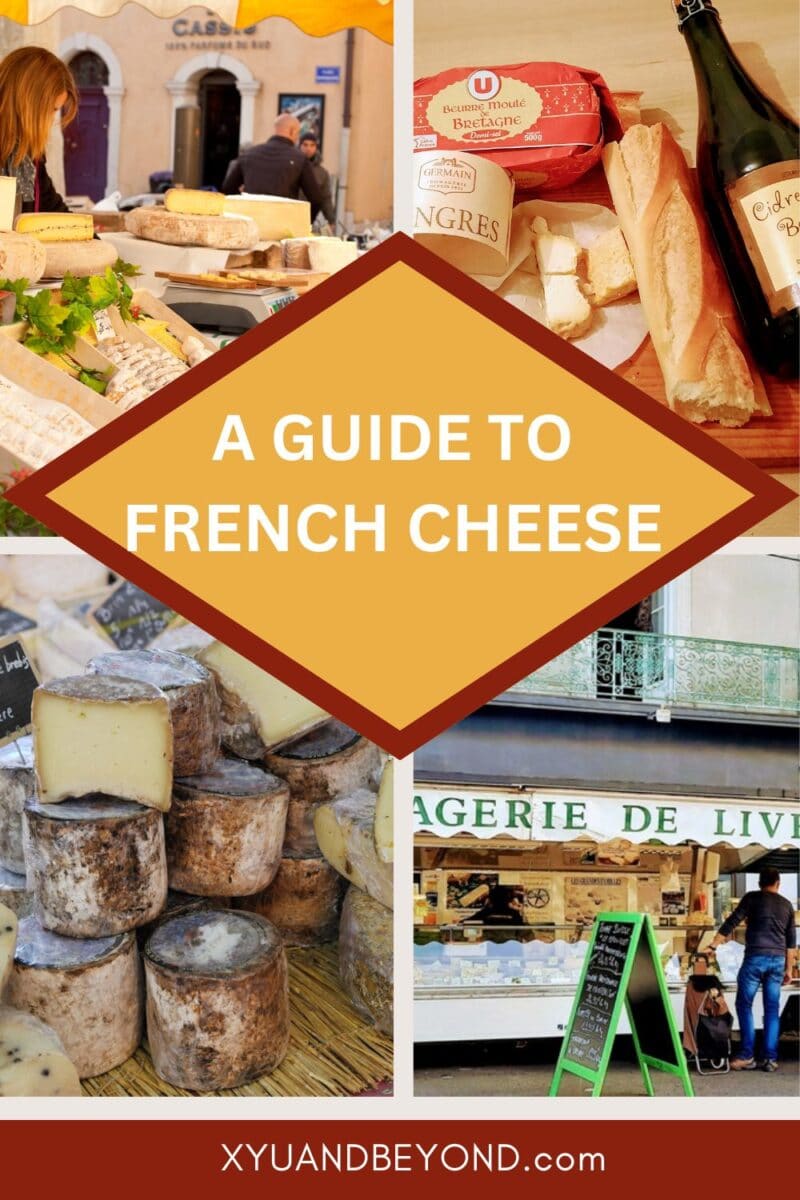Cheeses of France a Guide to French cheese
French President Charles de Gaulle asked (in 1962), “How can you govern a country which has two hundred and forty-six varieties of cheese?” How many cheeses are made in France? There are so many differences in the terroir of France that it leads to what some may claim as around 1,000 to 1600 distinctive types of French cheese.
I don’t know about you but the first thing I think of when I think of French food is fromages and bread. Of course, wine is the best addition to a cheese treat but here in Normandy or Brittany a cidre or cider from apples or pears is the best drink to have with your cheeseboard.
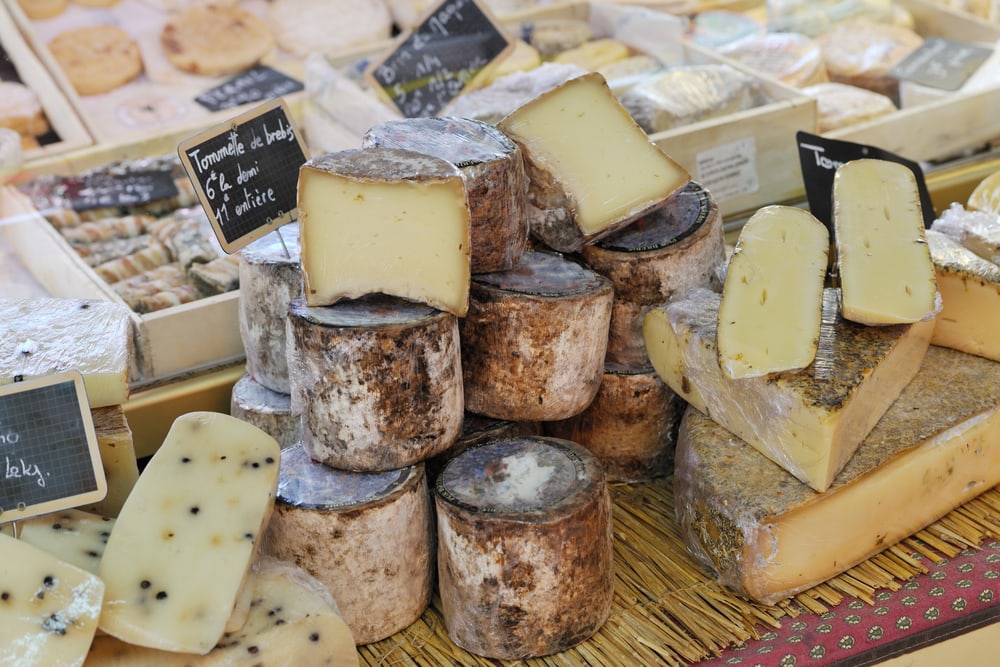
- Cheeses of France a Guide to French cheese
- Guide to French Cheese
- Varieties of French cheese
- FAQS about the Cheeses of France
- What are French cheeses known for?
- How is French cheese categorized?
- What is the difference between French Brie and Camembert?
- Can you describe Comté cheese?
- What are some popular French cheese regions?
- How are French cheeses paired with wine?
- What is the most famous cheese in France?
- What are the types of camembert cheese?
- History of French cheese
- How to set up a French cheeseboard
- Why do French people like stinky cheese?
- Types of French cheese
- 23 of the best French cheeses to try
- 13 French soft cheese to try
- 3 French Blue Cheeses to try
Guide to French Cheese
What is Terroir?
Terroir is one of those French words that has been thrown around by pretentious chefs for years now. In France, terroir is critically important to cheese and wine. Terroir means the actual region where the cheese is produced. Natural factors such as the source of the raw milk, the natural vegetation eaten by the animals, the mineral content in the soil all add up to a distinctive product.
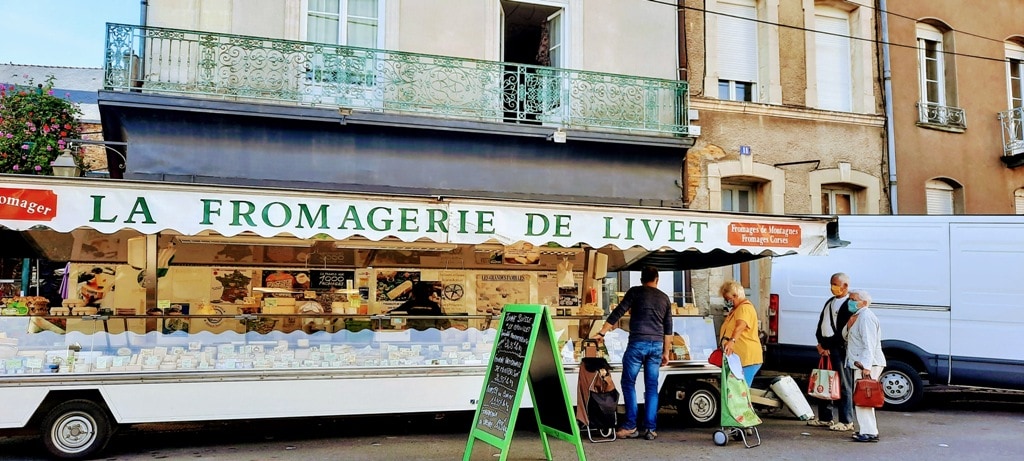
French Cheese designations
AOC – Appellation d’Origine Contrôlée – is a French label that means that everything from the cows/goats/sheep, to the method of making the cheese, is from a specific region associated with that cheese.
AOP – Appellation d’origine Protégée is European and is basically the same thing but refers to Europe. So, for example, you could make parmesan cheese in France but that’s not its official region of origin so this cheese would not have an AOP label. AOC is a French designation that guarantees strict methods of production specific to a particular terroir.
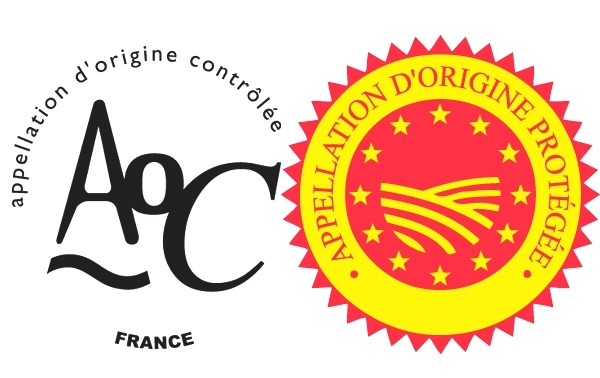
IGP – Indication Géographique Protégée”, or “Protected Geographical Indication” (PGI) in English. Specialities bearing the IGP seal are either produced, processed or refined in the place of origin.
PDO – Protected Designation of Origin is a European Union designation system that guarantees that the AOC standards have been met. PDO labelling tells you that the cheese is of excellent quality and is recognized as part of French gastronomic culture and heritage.
Having both AOC and PDO certification indicates the heritage and quality of the cheese. There are about 50 French cheeses that have both. There are around 40 cheeses that have been awarded the Appellation d’Origine Contrôlée status, which means they can only be produced in a certain region.
The cheeses with this status range from Camembert of Normandy, the Beaufort of the Savoie, Comté from Franche-Comté, Roquefort from Midi-Pyrénées, and Brie from Meaux and Melun. The newest French cheese to obtain the designation is the most recent addition to the list was the Rigotte de Condrieu from Lyon.
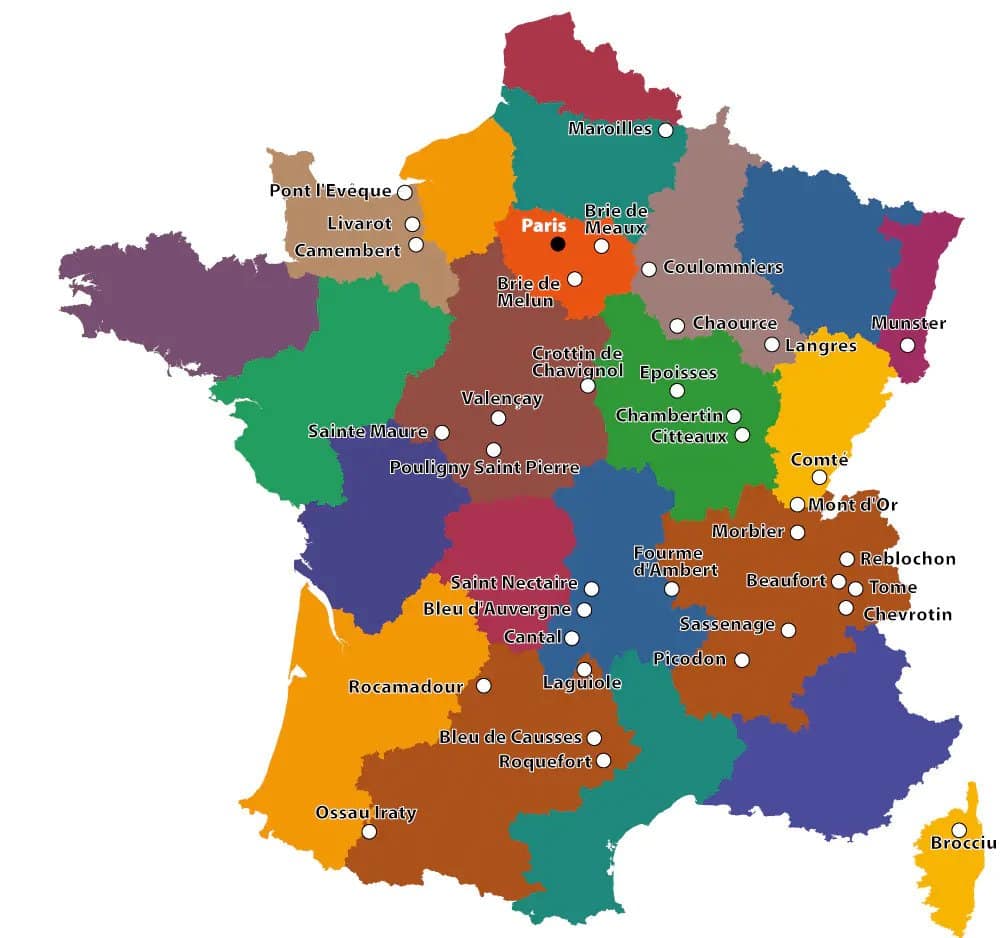
Varieties of French cheese
French cheeses are broadly grouped into eight categories, ‘les huit familles de Fromage.
- Fresh cheese: Boursin, Fresh Chèvre, Fromage Blanc, Queso Fresco, Paneer, Cottage Cheese
- Semi-Soft cheeses and white mould cheese: Brie de Meaux, Camembert, Valençay, Brillat-Savarin, Chaource
- Pasta Filata cheese: Mozzarella, Fior di Latte, Provolone, Caciocavallo, Oaxaca, Dil Peyniri
- Whey cheese: Ricotta, Brocciu, Brousse du Rove, Brunost, Urdă, Myzithra
- Blue cheese: Roquefort, Bleu d’Auvergne, Stilton, Gorgonzola, Persillé de Chèvre
- Pressed cooked cheese: Beaufort, Comté, Emmental, Gruyère, Pecorino, Parmigiano Reggiano
- Soft washed rind cheese: Epoisses de Bourgogne, Langres, Livarot, Maroilles, Munster, Mont d’Or
- Pressed uncooked cheese: Morbier, Reblochon, Raclette, Fontina, Cheddar, Gouda, Manchego
FAQS about the Cheeses of France
What are French cheeses known for?
French cheeses are renowned for encompassing a wide range of flavors and textures, from creamy cheese like brie and blue cheese to nutty comté and rich roquefort.
How is French cheese categorized?
Cheese in France is classified based on factors such as appellation, region of origin, and milk cheese used. Categories include soft, semi-soft, and hard cheese varieties.
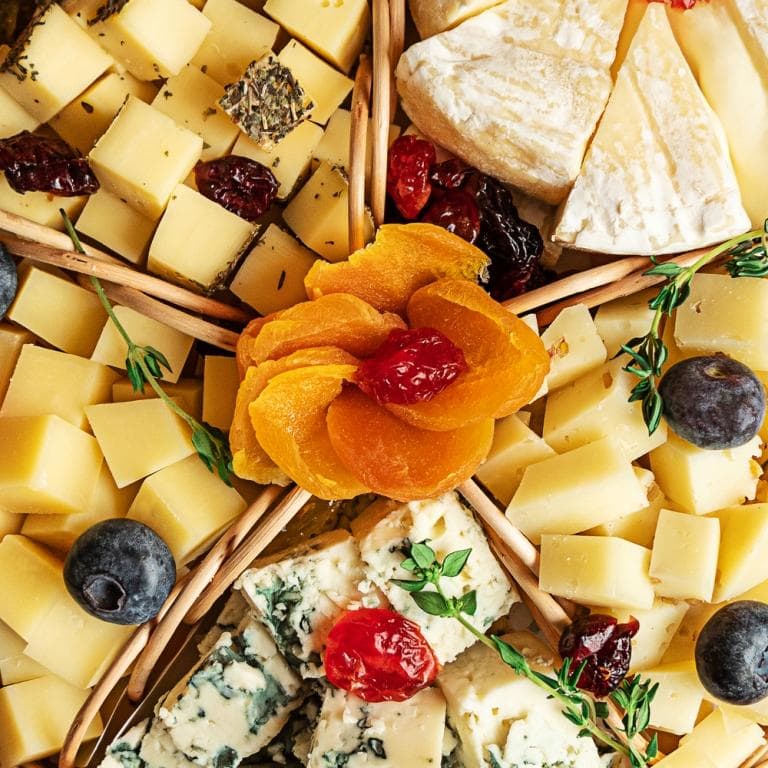
What is the difference between French Brie and Camembert?
Brie and camembert are both soft cheeses from Normandy. While Brie is made from cow’s milk cheese, camembert has a stronger flavor and ripe rind.
Can you describe Comté cheese?
Comté is a French cheese made from raw cow’s milk cheese in the Jura region. It is known for its nutty flavor, semi-hard texture, and distinctive rind. I found this cheese to be a great substitute for cheddar.
What are some popular French cheese regions?
Normandy, Auvergne, and the Alps are well-known areas for cheese production in France. They are renowned for artisanal cheeses like Brie de Meaux and Beaufort.
How are French cheeses paired with wine?
French cheeses are often enjoyed with wine, with common pairings including comté with red wine and Brie with champagne. The flavors complement each other well.
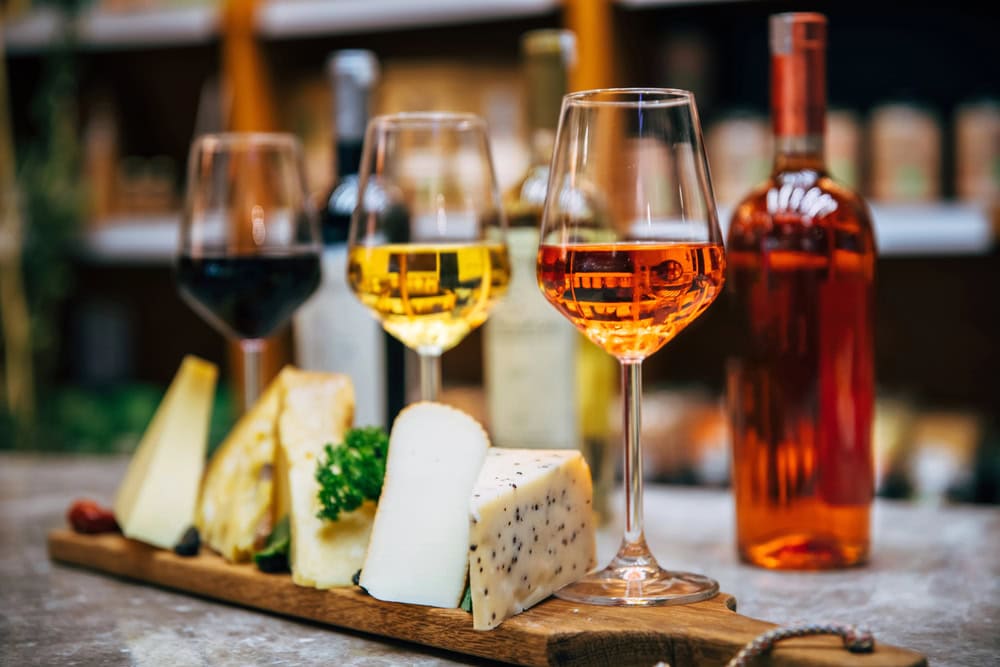
What is the most famous cheese in France?
Camembert is probably the most famous French Cheese it is probably the first cheese you think of when you think of French Cheese.
What are the types of camembert cheese?
Fresh Camembert cheese is bland, hard and crumbly in texture. Young Camembert has a milky and sweet taste. As the cheese matures, it forms a smooth, runny interior and rich, buttery flavour. The white bloomy rind is because of a white fungus.
History of French cheese
According to legend, cheese production was discovered in the Neolithic period when milk was stored in a sack created from the stomach of grass-eating animals such as sheep and goats – cows came later. In the sack the rennet that occurs naturally turned the milk into curds and then into whey.
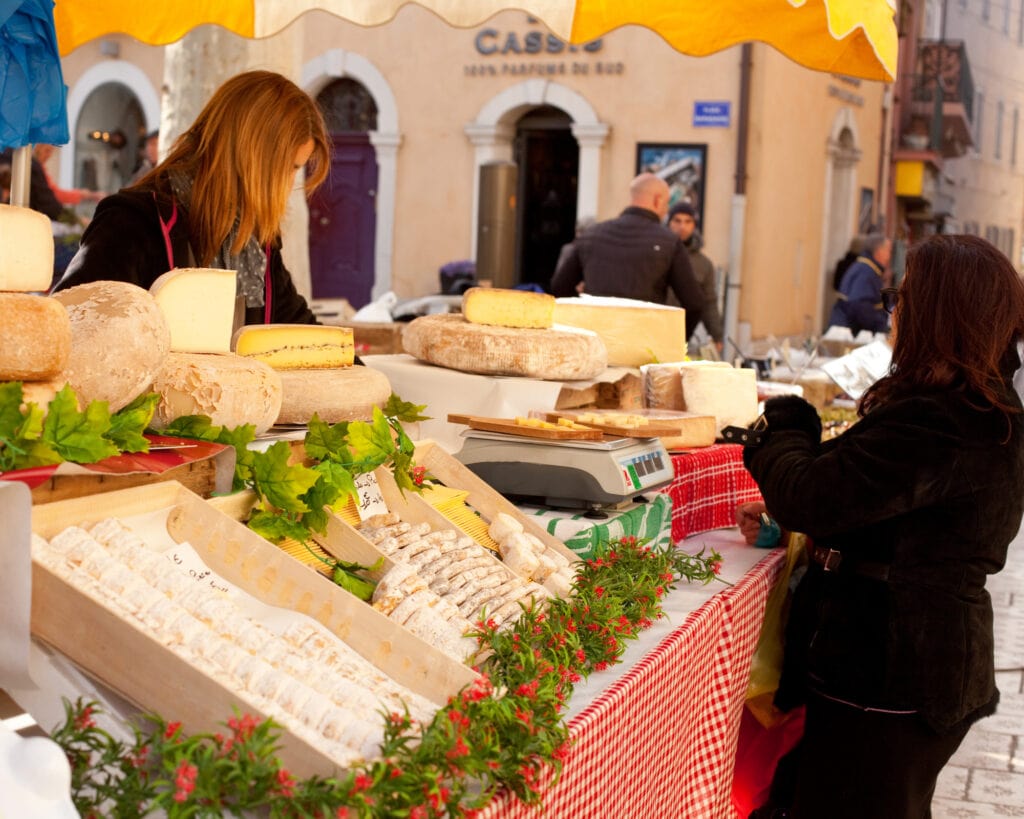
Cheese became the reason that herds began to be cultivated and often cheese was used to pay taxes or as currency. The oldest cheese ever found was discovered by archaeologists in an Egyptian tomb dating back 3,200 years.
Most cheeses were initially recorded in the late Middle Ages. Cheddar was recorded since the 1100s, Parmesan (Parmigiano Reggiano) was founded in 1597, Gouda in 1697, and Camembert in 1791.
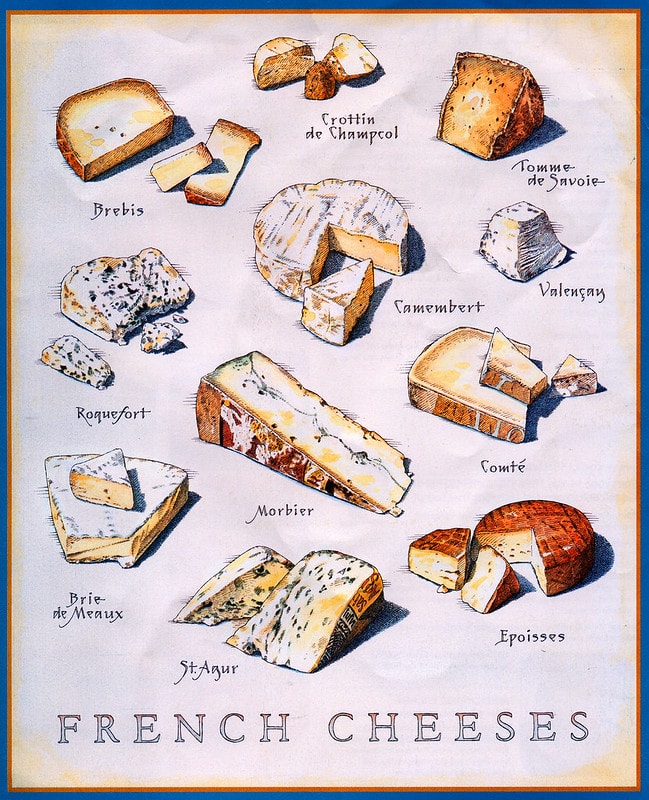
How to set up a French cheeseboard
Traditionally, in France, a selection of luscious cheeses is the usual dish that comes after your mains instead of desert in many cases. Generally speaking, a French cheese board has a minimum of 3 kinds of cheese, too many and the palate becomes overwhelmed. A good cheese board is about balance.
To set up your cheese board according to the experts you should think of the board like a clock with the mildest cheese at 12 and the most pungent (to put it nicely) will be the last cheese on the board.
You should select your cheeses from one of the major styles which simply means a soft-ripened cheese, then a semi-hard, a washed rind, and a pungent blue.
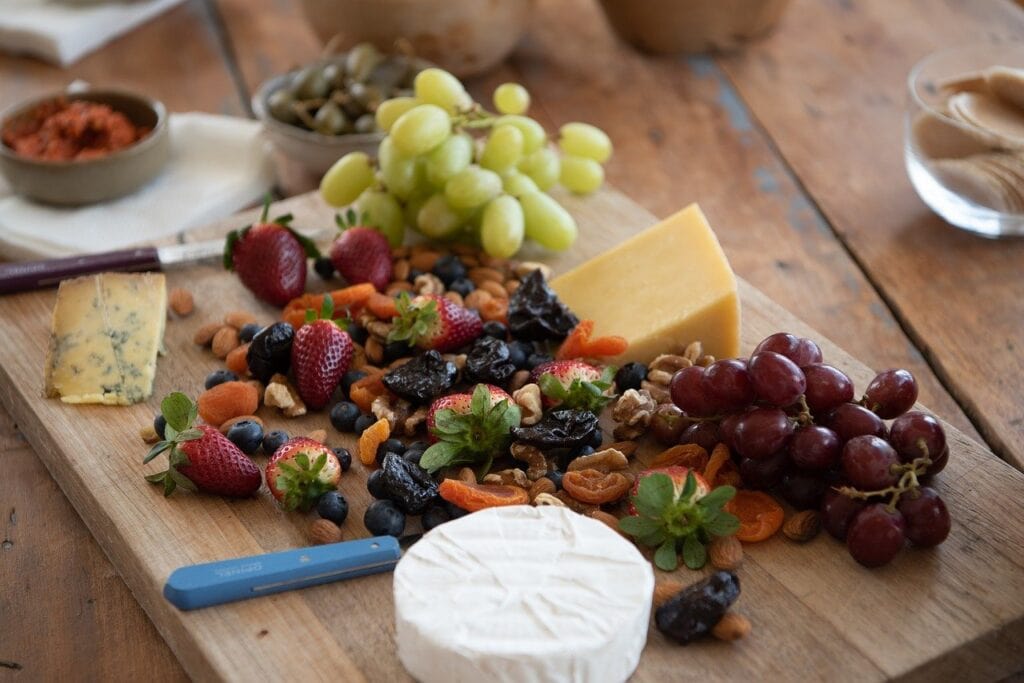
Your cheese board should be served with a neutral-flavoured cracker of a simple baguette traditional plain no butter and most definitely not a savoury bread or cracker. The cheese is the star here not the carb it is served on.
Lastly, to add a bit of sweetness to balance the cheese you can add bits of fruit such as grapes or figs you could also use some beautiful pastes like quince or mango and if you prefer a hit of heat try a chilli paste or jam.
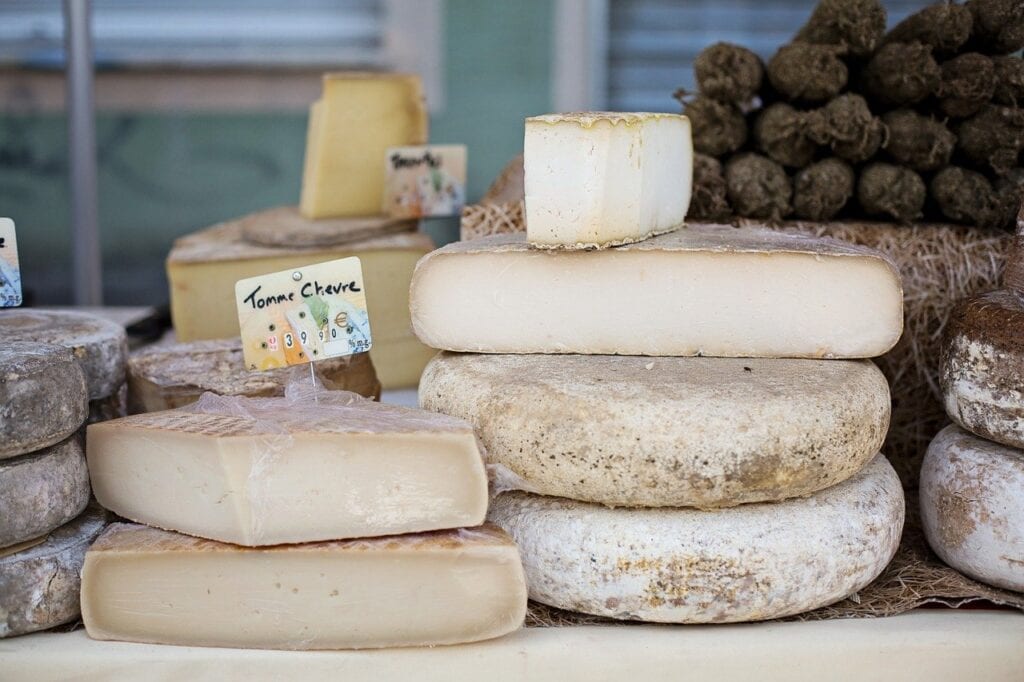
Why do French people like stinky cheese?
The more shall we say aromatic a cheese is the more the French love it. For the French, a cheese must have flavour and smell. In a food show Food—Delicious Science the host James Wong explains why stinky cheese tastes so good.
“The sulfur-like, stinky-sock-smelling, volatile aroma molecules from stinky cheese stimulate a unique combination of receptors to help us identify the smell,” he explains. “But when you eat it, something magical happens: The aroma compounds are released in your mouth and they waft up the back of your nose. They’re detected by the same smell detectors, but weirdly your brain perceives them as very different than if you lean forward and sniff them up the front of your nose.”
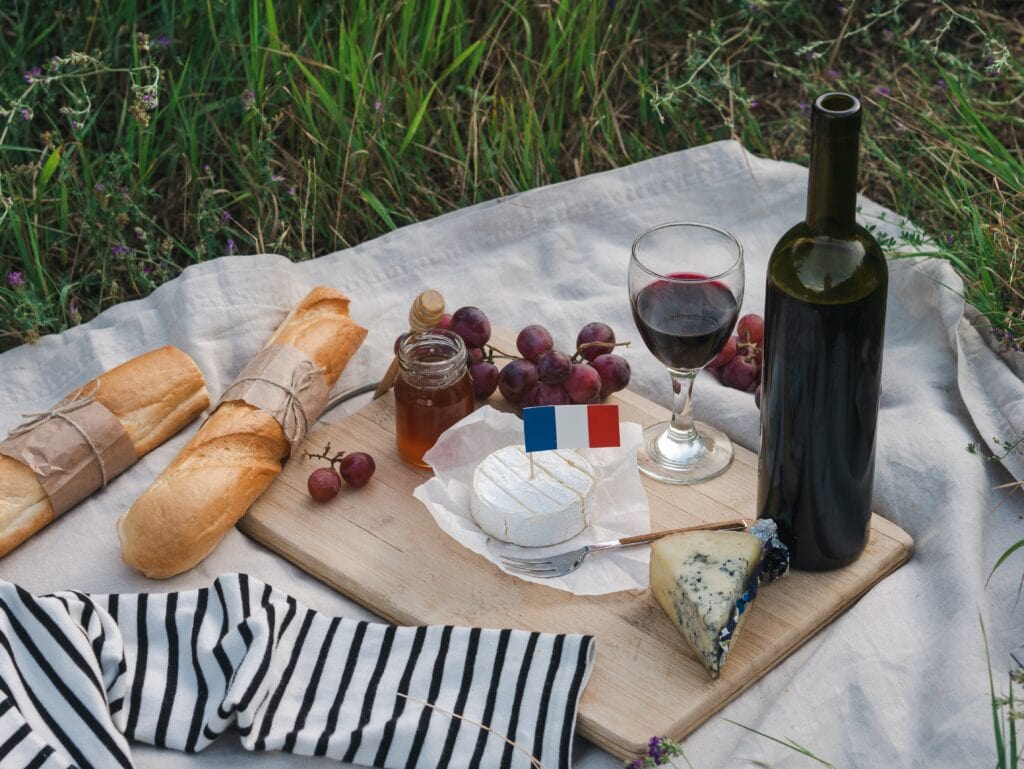
Types of French cheese
Here in France, you have virtually unlimited cheese options but here are the most popular types of French cheeses
- White Mold Cheese – Brie de Meaux, Brie de Melun, Camembert, Brillat Savarin
- Washed Rind Cheese – Mont d’Or, Epoisses, Pont L’eveque, Cure Nantais
- Uncooked semi-hard cheese – Tomme
- Cooked and pressed cheese – Emmental and Gruyère
- Hard Cheeses – Cantal, Comte, Crottin de Chavignol, Edam
- Goat Cheeses – Selles sur Cher, Bouton de Culotte
- Blue Cheeses – Bleu d’Auvergne, Roquefort, Fourme d’Ambert
- Ewes Milk Cheeses – Roquefort, Brocciu
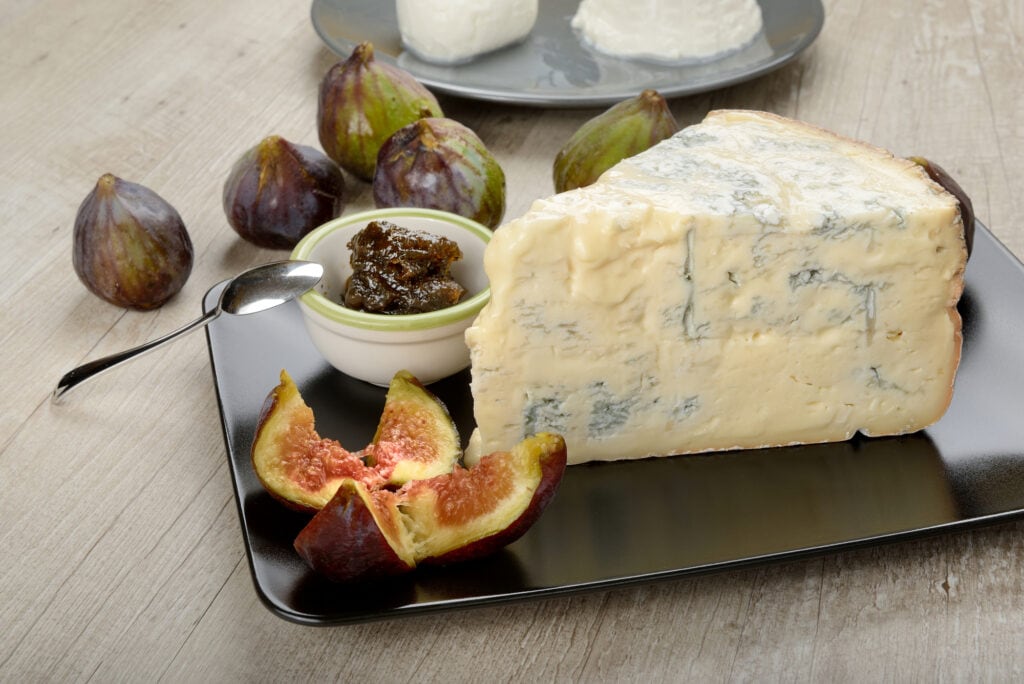
23 of the best French cheeses to try
13 French soft cheese to try
Camembert
This is a soft spreadable cow’s milk cheese originally from a village in Orne Normandy called – wait for it – Camembert. Legend says that the Benedictine Abbot of Rouxville who saved the Harels from the French revolution shared with Marie Harel his tips for making cheese. Mdme Harel created Camembert which is aged slightly less than Brie.
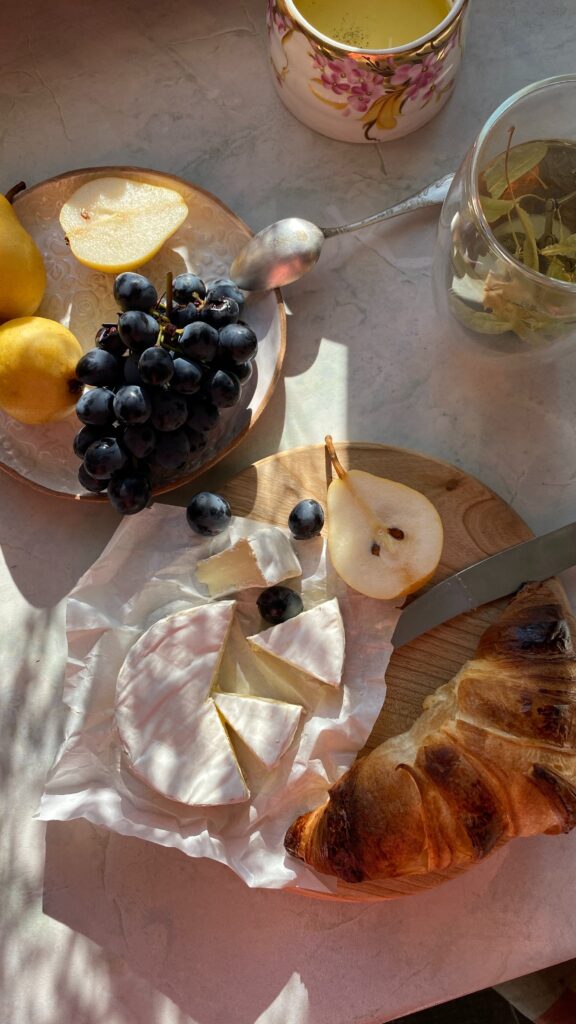
Brie de Meaux and Brie de Melun
Brie was first created in the area of Meaux and Melun, 35 miles east of Paris. Like many kinds of cheese, it was invented by monks as early as the 7th century.
Charlemagne famously declared “I have just discovered one of the most delicious things” when referring to his taste of brie in 774.
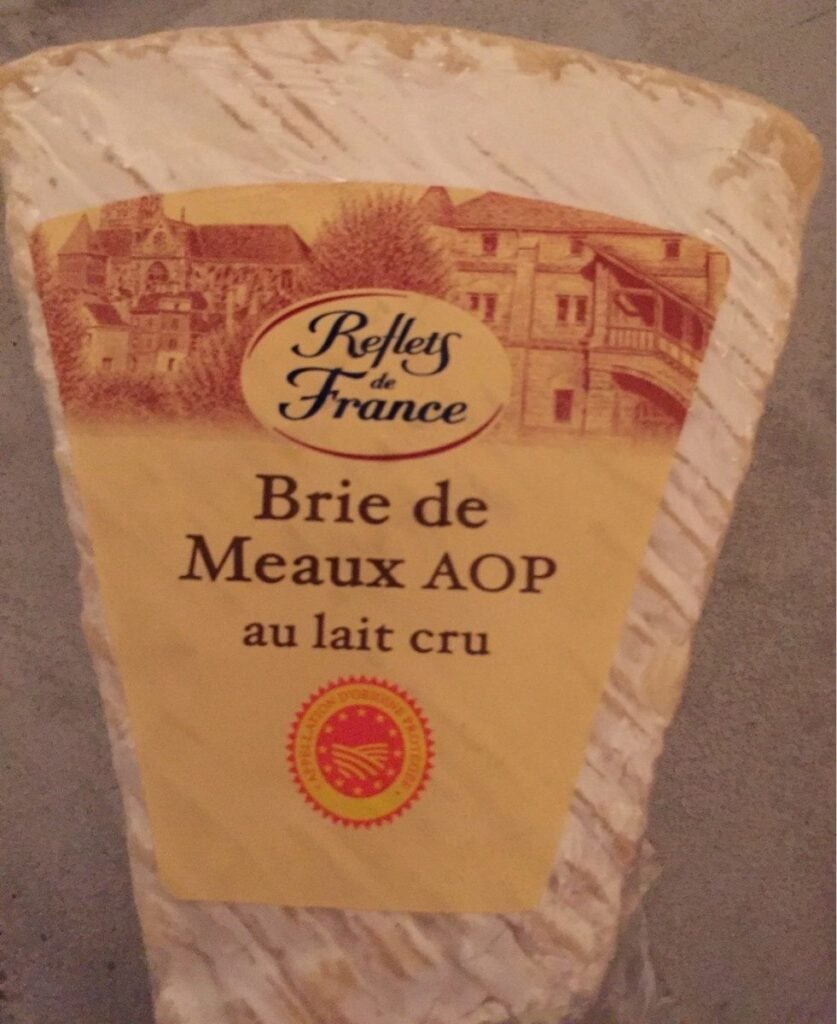
Louis XIV loved it and wanted it served every day and English Kings including Henri IV. Henri’s Queen always requested that the cheese be served to please her husband and according to legend, he favoured enjoying a Brie with his wife, Queen Margot, rather than joining his mistress, Gabrielle d’ Estrées.
Traditional French bries are made with unpasteurized, raw milk, aged 40 to 60 days. Unfortunately, this means they are banned in the United States due to FDA regulations. To work around this, French producers simply use pasteurized milk, producing a cheese that’s still delicious, if not quite the same in flavour.
Brie is banned in the USA and in parts of Canada (excluding Quebec) because Brie is made from raw unpasteurized milk.
There are differences between the French aged cheese Brie de Meaux and the Brie de Melun, which is mainly down to the way the cheeses are aged. The Brie de Meaux is aged for 4 to 8 weeks, whereas the Brie de Melun is aged for 4 to 12 weeks.
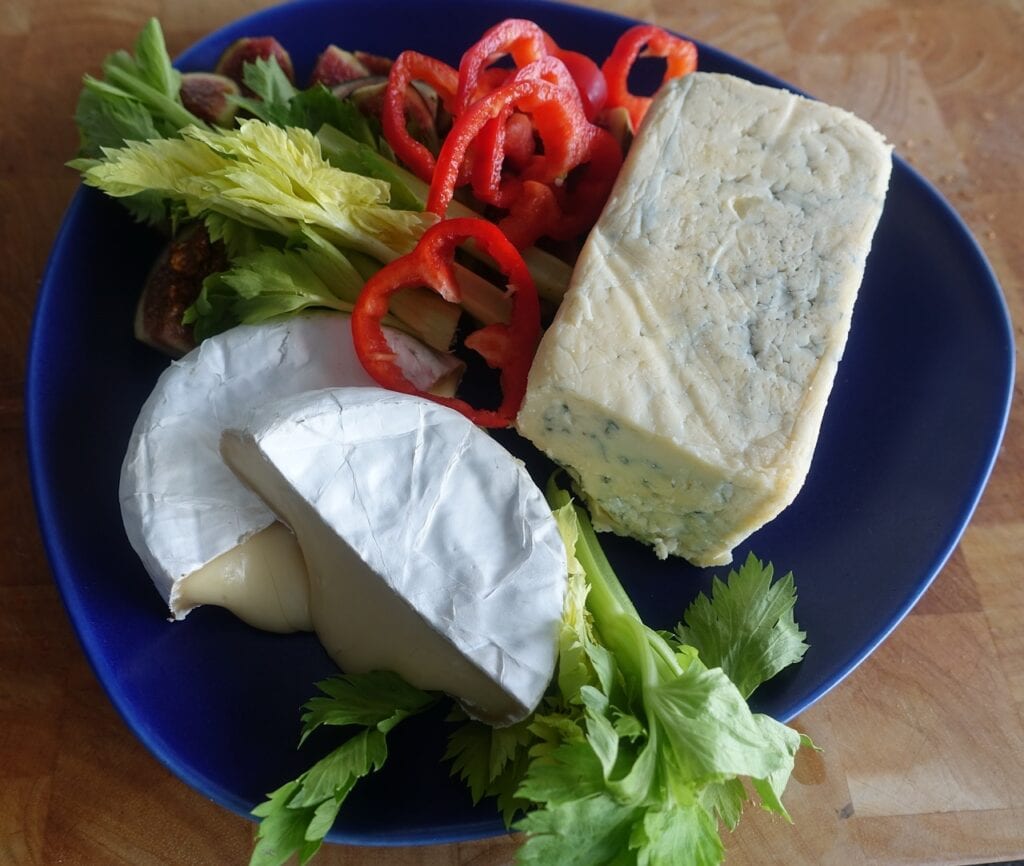
The differences in the cheese come down to the way each is made and processed. The Brie de Meaux is a fast production around 30 minutes as the milk is coagulated using rennet. The de Melun process used lactic fermentation which takes around 18 hours. Brie de Meaux has a refined flavour and a soft texture, Brie de Melun is smaller in size and tends to be a more robust cheese, often quite salty and with a firmer texture.
Brocciu
Brocciu is a cheese made on the Island of Corsica a French territory in the Mediterranean that is nicknamed the Island of Beauty. Brocciu can be found fresh or matured, made on Corsica island from goat’s or sheep’s milk and whey. It has a smooth, creamy and crumbly texture and if fresh best eaten after straining in a cheesecloth. It has a sweet milky taste perfect for making pastries, cheesecakes and the like.
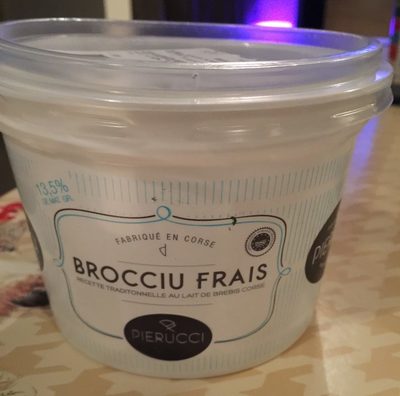
Selles-sur-Cher
I never saw this gorgeous goat cheese in any stores in the north of France until we visited the Loire Valley. The Selles-sur-Cher is named after the village that created it. The first written notes on this cheese date from the XIXth century, where a native farmer of the township explains that she always made Selles-sur-Cher, like her mother before her.
Selles-sur-Cher is a soft cheese made from full-fat goat’s milk, dusted with wood ash to develop a unique rind with strong mineral notes. Its texture is soft and sort of claggy but it tastes of nuts, salt and grass the ash that the rind is coated in gives it a sharp flavour.
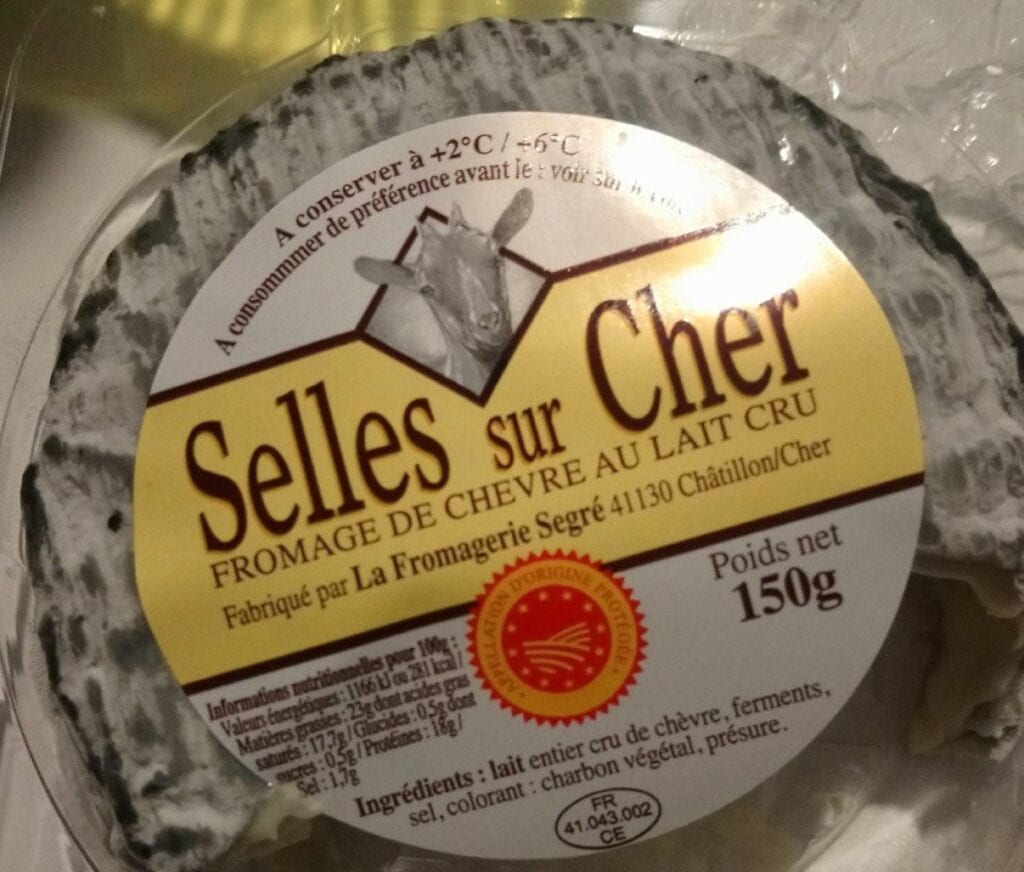
Mont d’Or
Mont d’Or Soft rind-washed cheese, the Mont d’Or, also called “Vacherin du Haut-Doubs” or “Vacherin Mont d’Or” in Switzerland, is named after the highest point of its native relief. It was invented by the massif farmers to remedy the insufficient milk collecting to produce Comté.
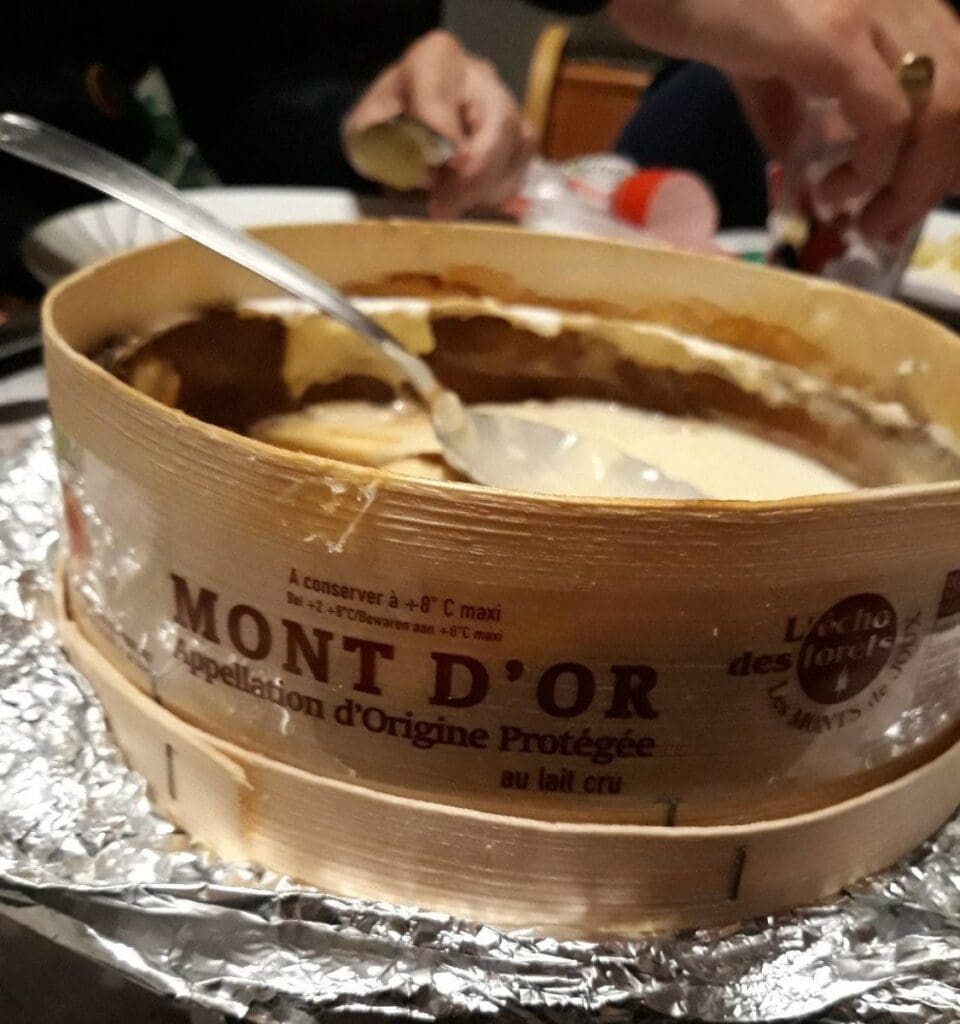
Unlike the Swiss who are using scalded milk, French Mont d’Or is exclusively composed of raw milk. It is also nicknamed “boëte cheese” or “strapped cheese” because of the spruce bark belt, which keeps “its shape” and gives it a woody perfume.
Neufchâtel
Neufchâtel is made in Normandy from unpasteurized whole milk The cheese is crafted by hand and the milk that has been coagulated hangs in cheesecloth for at least 12 hours. During this time the bacteria in the milk format a layer of very white mould around the cheese, it is then aged in a cave for a minimum of 3 weeks. Stories say that the reason this cheese is heart-shaped is it was created by a young girl who gave her heart to her future husband made of Neufchatel.
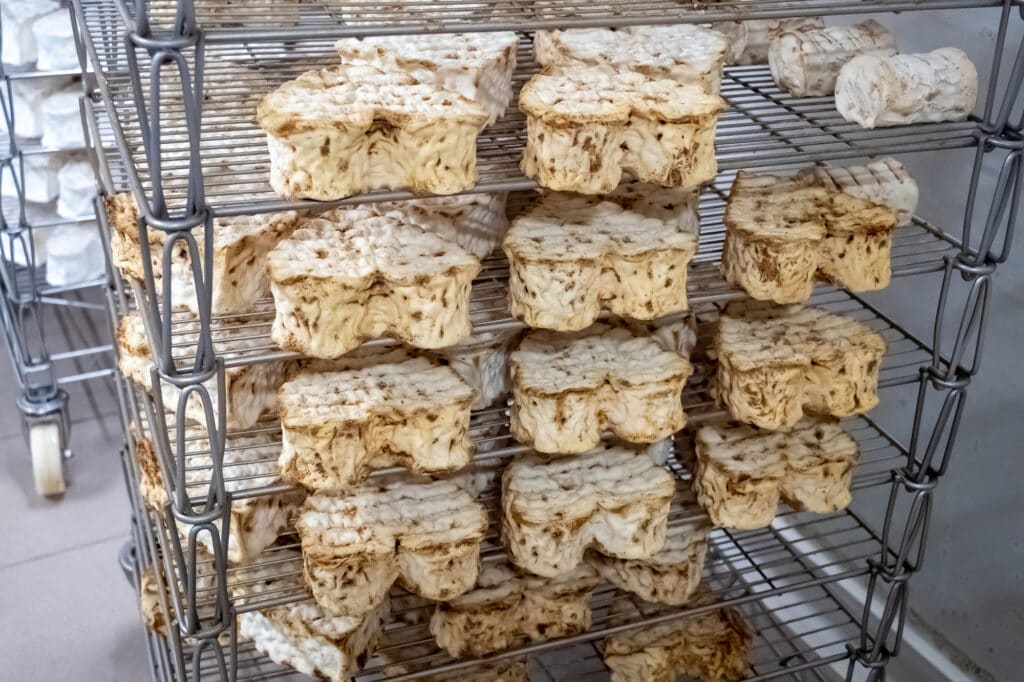
Boursin
I was surprised to see Boursin cheese everywhere here in France. I wrongly assumed it was some marketing genius who thought Boursin up. But this is a cheese that was invented in France in 1963 and it is well-loved by the French. Available in a variety of flavours Bourson is a perfect introduction to soft French cheese.
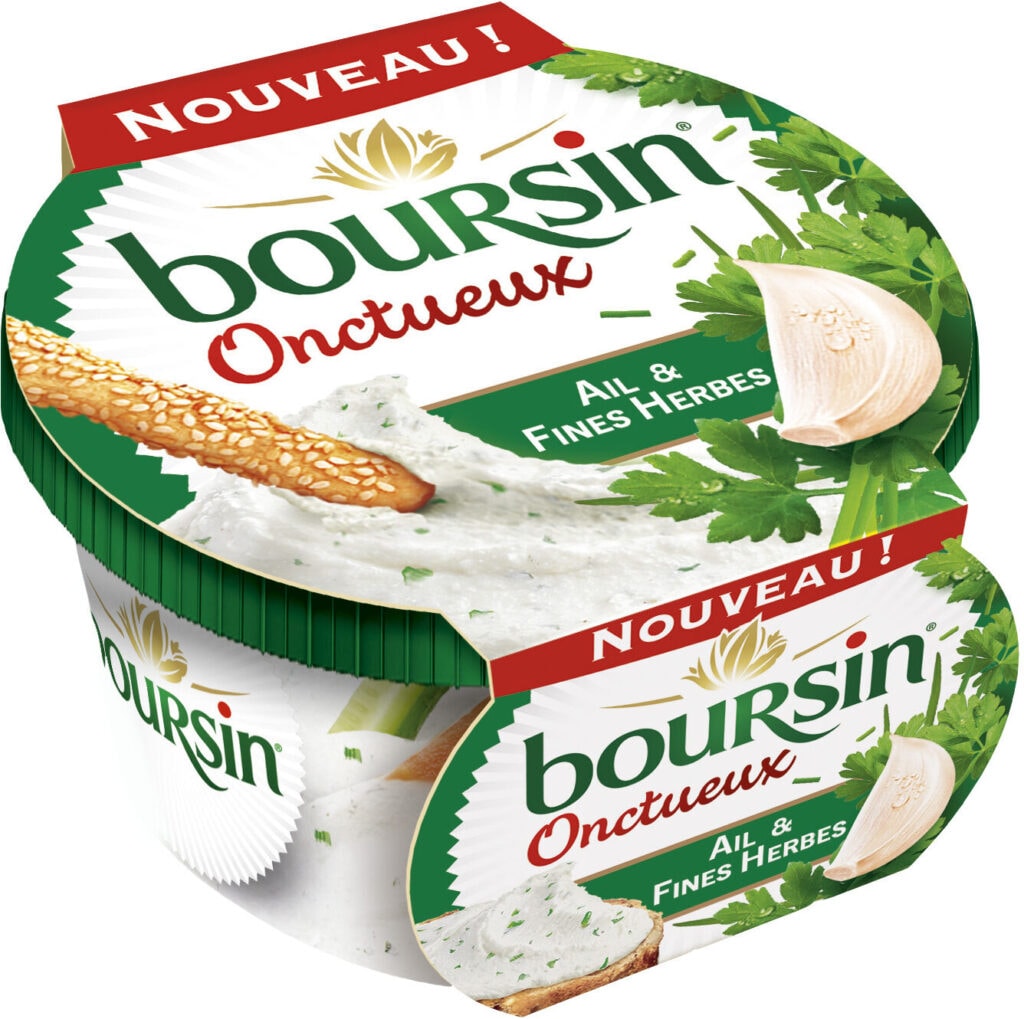
Reblochon
Reblochon’s was created in the 18th century, in the Thones valley, Haute-Savoie. In medieval times farmers did not own the land they farmed and they had to pay a tax of sorts on the milk produced by the cows.
The “Rebloche” was a way of pinching the cow’s udders twice so they didn’t have to pay the tax. The milk that was obtained from this was very creamy and perfect for cheese making. Reblochon has a creamy texture, with a nutty aftertaste and a strong herbal aroma. The cheese is aged in cellars or caves in the mountains; it is turned every two days and washed with whey to speed the ageing process. Reblochon is also melted on baked potatoes, and used with tartiflette (which is sort of like scalloped potatoes on steroids).
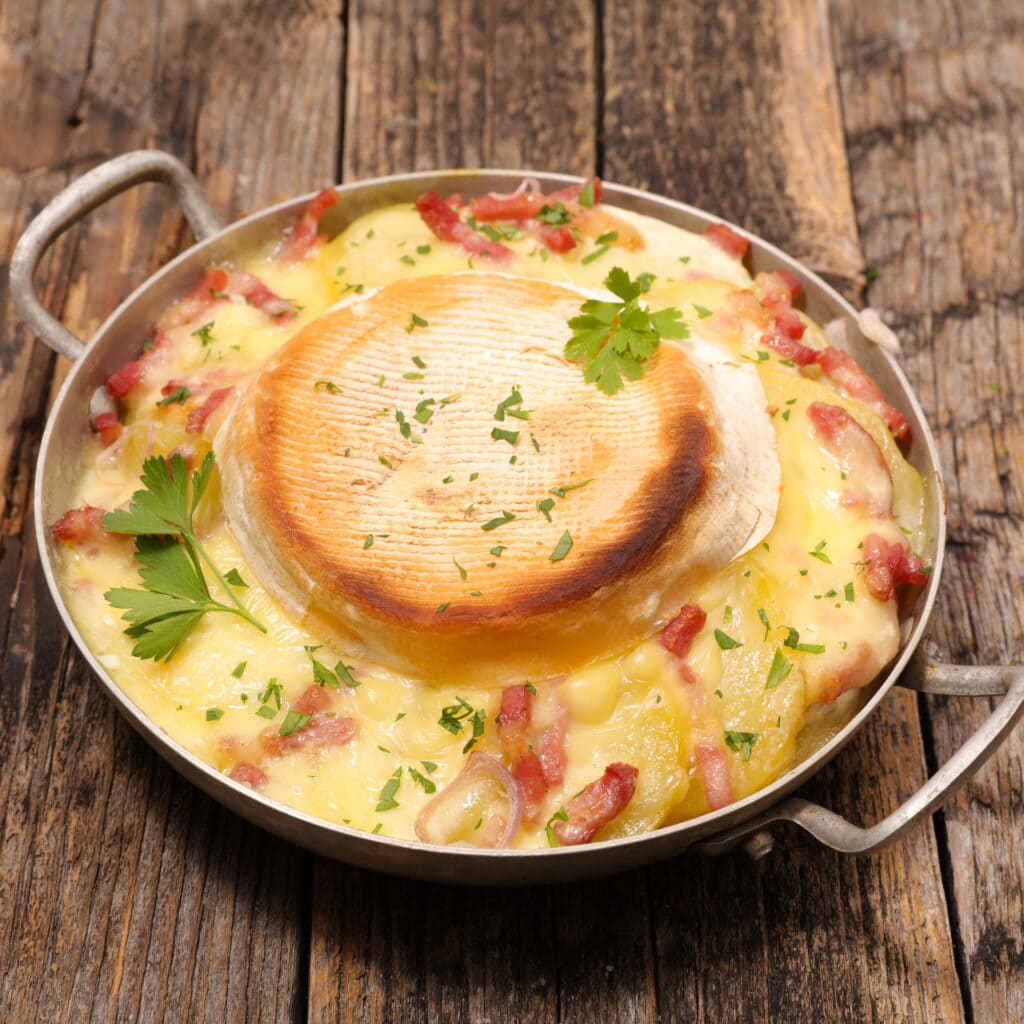
Pont-l’évêque
Pont l’Evèque is one of Frances oldest cow’s milk cheeses it was born in Calvados. It’s a soft creamy cheese that is pale yellow in colour with a very fine soft texture but packs a full-bodied flavour with quite a pungent aroma.
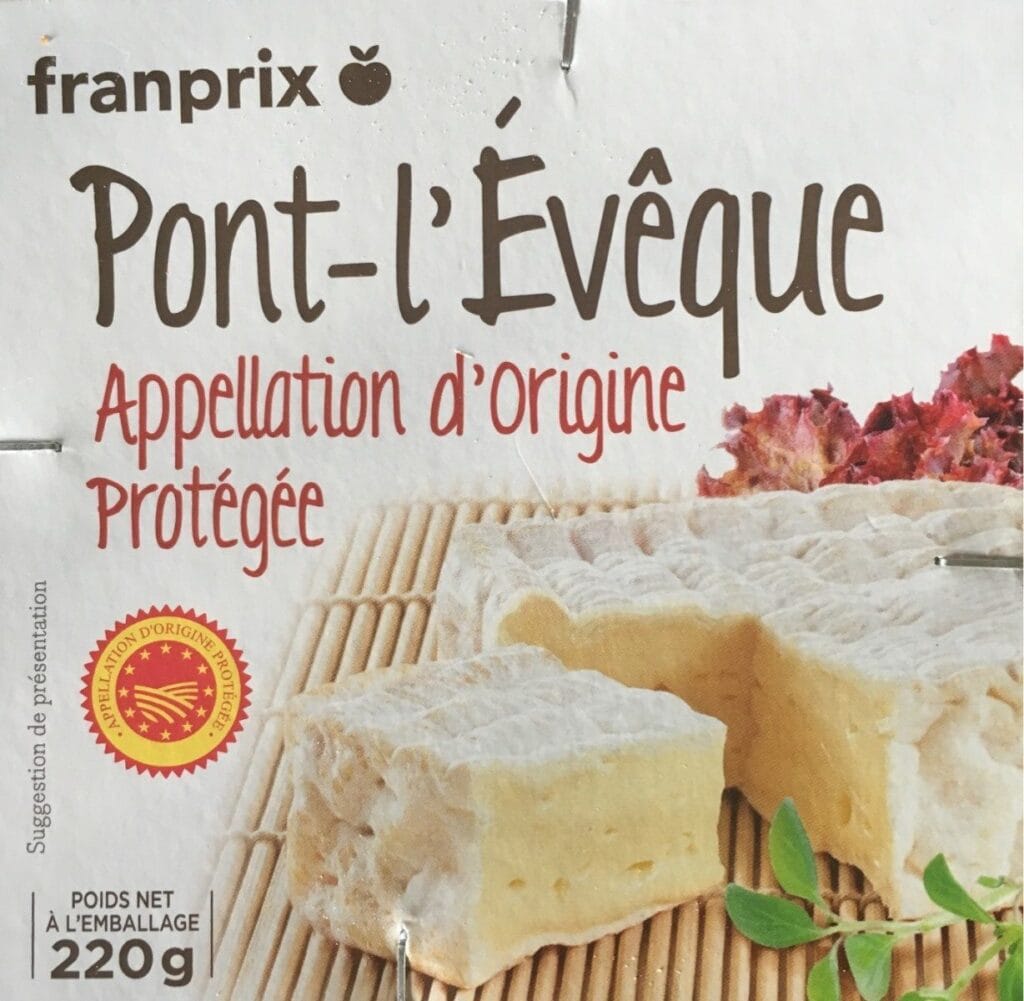
Époisses de Bourgogne
Epoisses is a cheese made with unpasteurized coagulated milk. It is first washed with salty water and aged in a humid cellar for a month. After the first ageing, it is washed again with a mix of rainwater and Marc de Bourgogne’s brandy. This brandy or pomace is made from the leftovers of the grapes used in winemaking, in Italy it is known as grappa.
After WWII the making of Epoisses nearly died out due to the makers of the cheese, mainly men, were killed in the war. In the 1950’s it was brought back to life by the Berthauts.
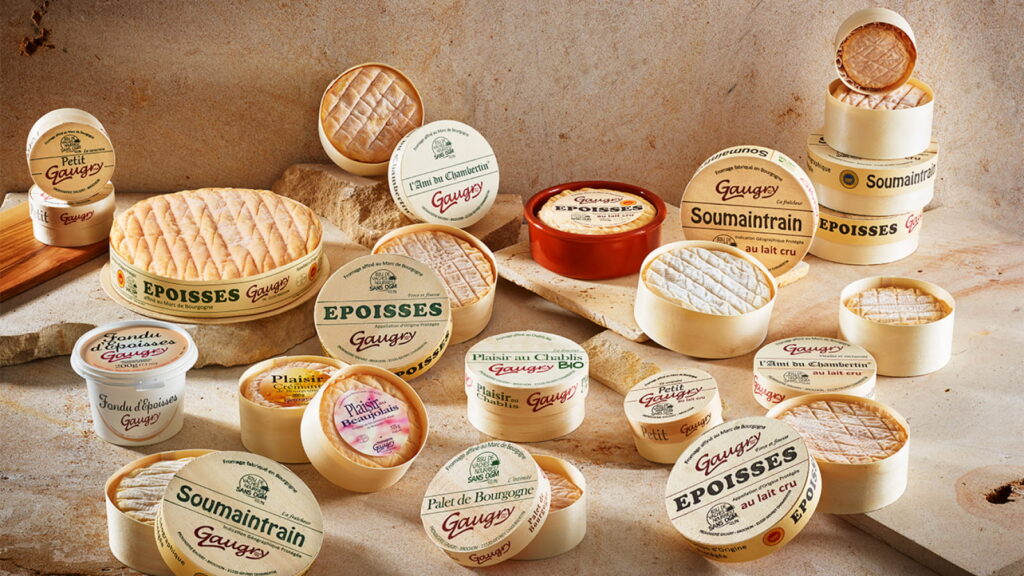
Brillat Savarin
Brillat Savarin is from Burgundy and it’s a creamy buttery triple cream cow’s milk cheese. Creamy, buttery and slightly sour in flavour, it can be dressed up both savoury and sweet.
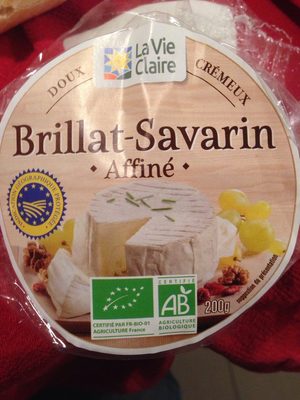
Cure Nantais
Cure Nantais is the ‘priest cheese’ and it’s a soft rind-washed cow’s milk cheese that is sold in three shapes. A square with round corners, a large round shape and a small round washed with Muscadet wine. It is aged on spruce boards giving it a distinctive flavour of grassy pine.
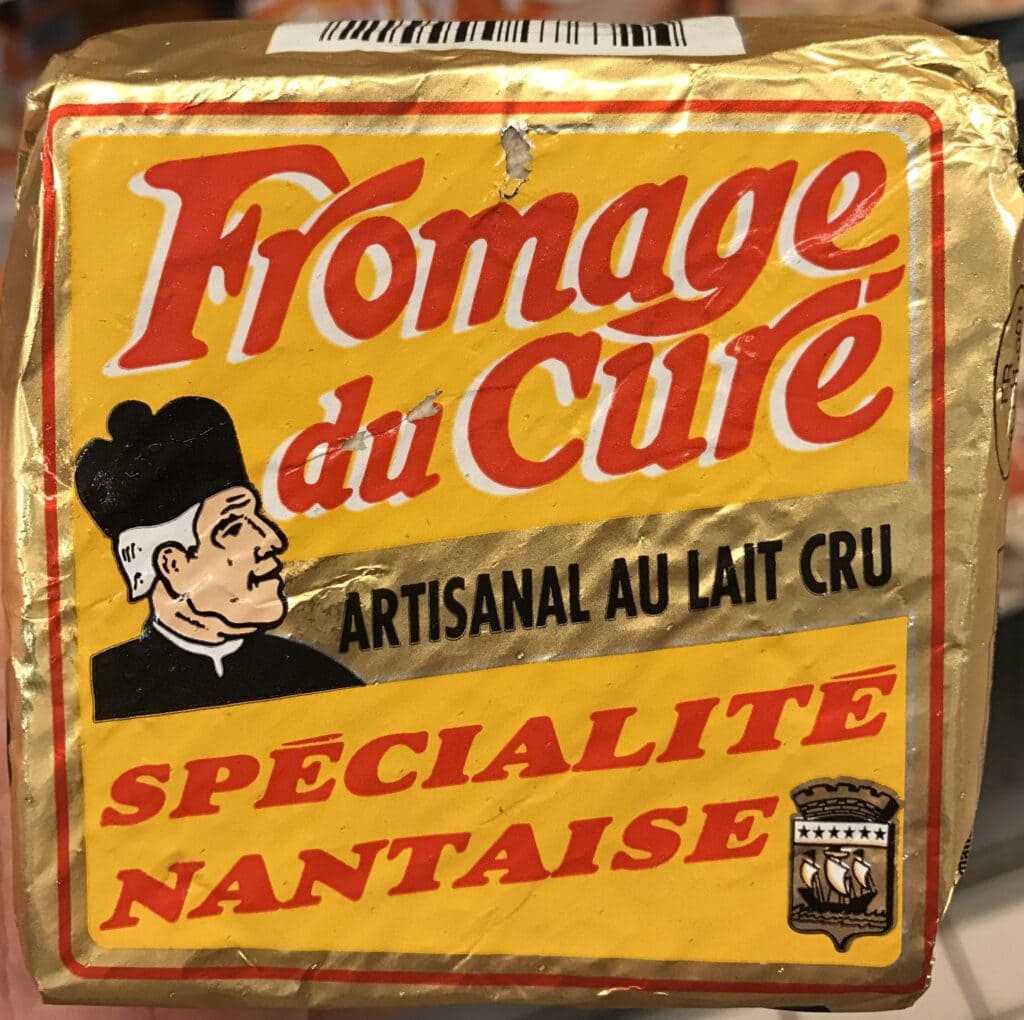
7 French hard cheeses to try
Comté
This is one of my favourite hard French cheeses when I am craving a cheddar. Comte has an interesting sweet taste that includes hints of butter, cream, hazelnuts, apricots and is lovely in a cheese and tomato sandwich.
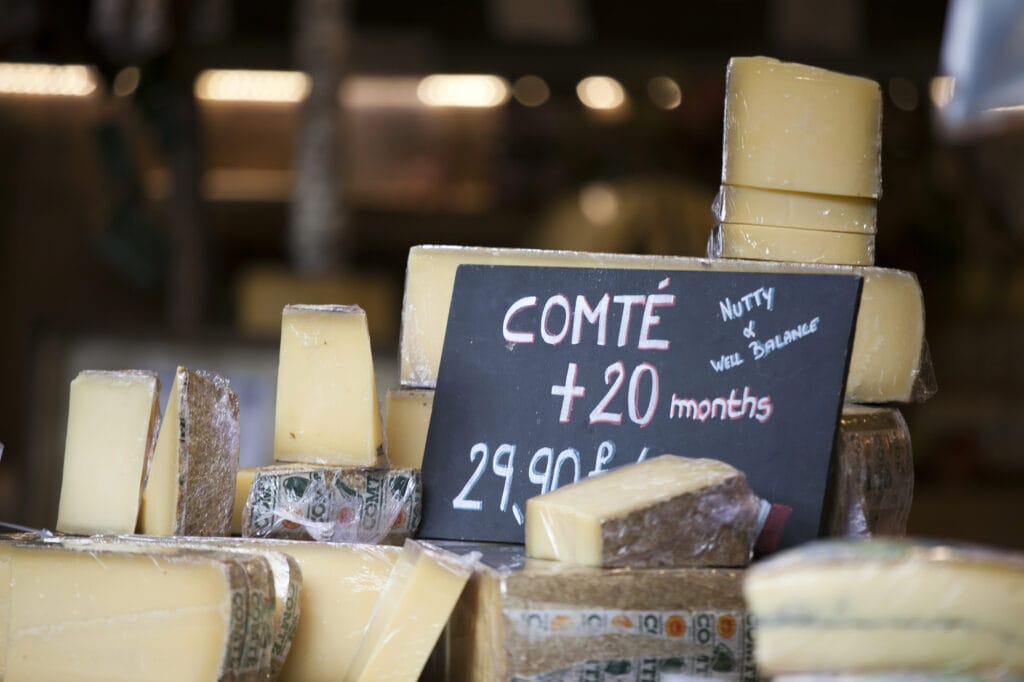
Comte is has a soft yellow interior and a dark rind and it is pressed cow milk’s cheese that has been made since the 12th century. Some don’t remove the rind before eating but most French do. Comte has several grades here in France and I like to buy the Comte Extra because it indicates that it is rated excellent for texture, colour and quality.
Crottin de Chavignol
One of the most famous of goat cheeses or Chèvre is the Crottin de Chavignol, which is a hard cheese made with raw milk.
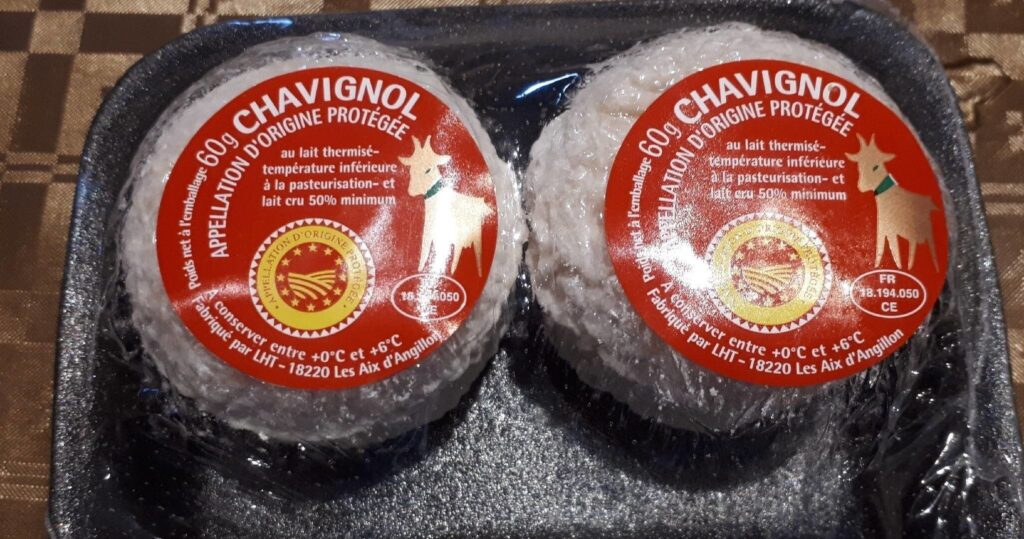
Bouton de Culotte
A small French goat cheese in the shape of a button this cheese is from the Maconnais and Haut-Beaujolais region. The cheese has aged a minimum of 14 days but is best when it’s older than 2 months as the peppery taste comes out more at that age.
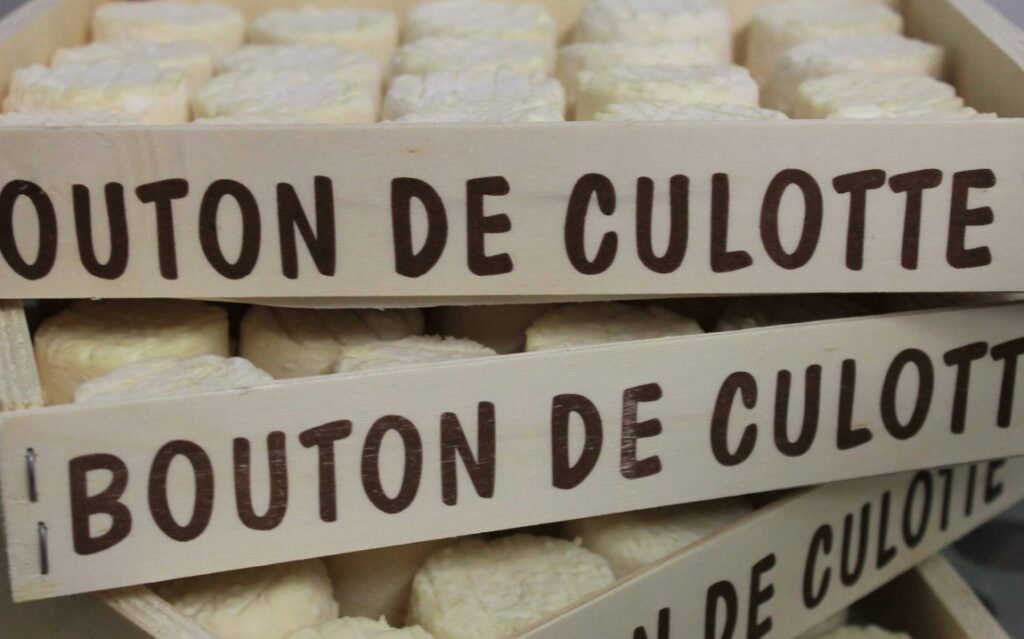
Cantal
What is a French cheese like cheddar? Cantal is a pressed, uncooked cow’s milk cheese a kind of french cheddar.
What is the oldest french cheese? Cantal is one of the oldest cheeses in history, 2000 years ago, Cantal cheese was granted Appellation d’Origine Contrôlée certification in 1956. One of the oldest cheeses in France, Cantal dates back to the times of the Gauls. It came to prominence when Marshal Henri de La Ferté-Senneterre served it at the table of Louis XIV of France.
There are two types of Cantal cheese: Cantal Fermier, which is made from raw milk; and Cantal Laitier, a mass-produced version made from pasteurized milk. Both have to adhere to the same strict quality controls. The cheese is made only using milk from hay-fed Salers cows and is only harvested from November 15 to April 15.
Cantal is another great French cheese if you can’t find cheddar here in France as is has the same rich buttery depth as a well-aged cheddar.
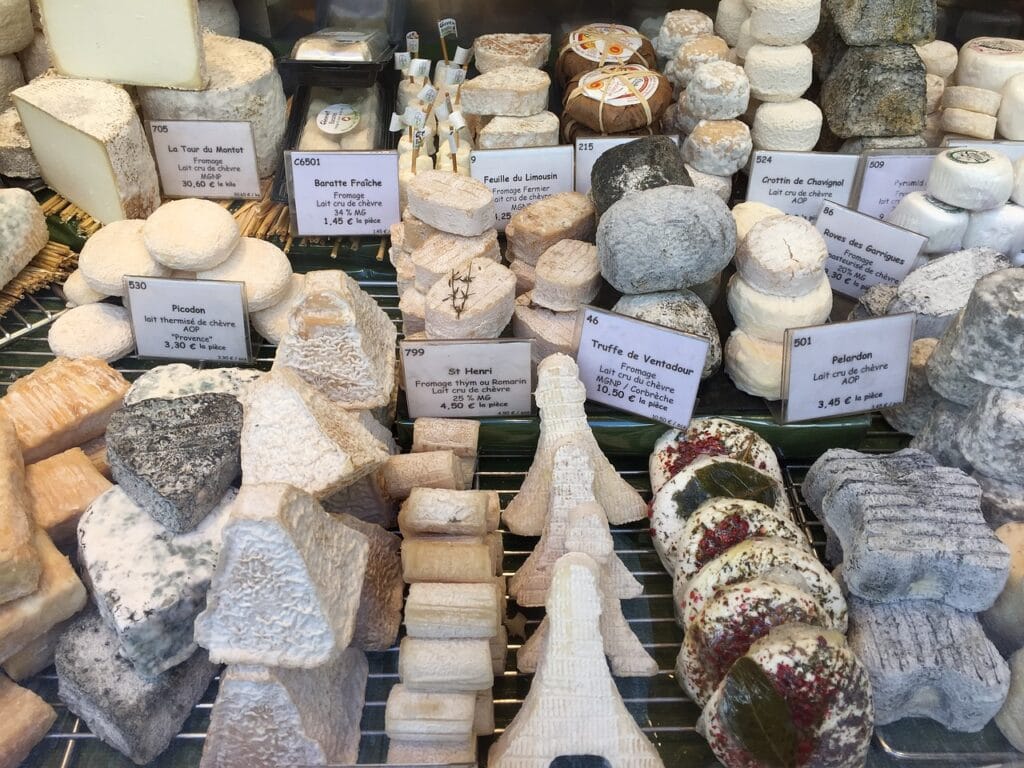
Munster
Munster cheese is made of raw cow’s milk and it is a soft, rind-washed cheese. It was developed by monks in the 12th. The first known mention of Munster is noted in the Marquard treaty in 1339.
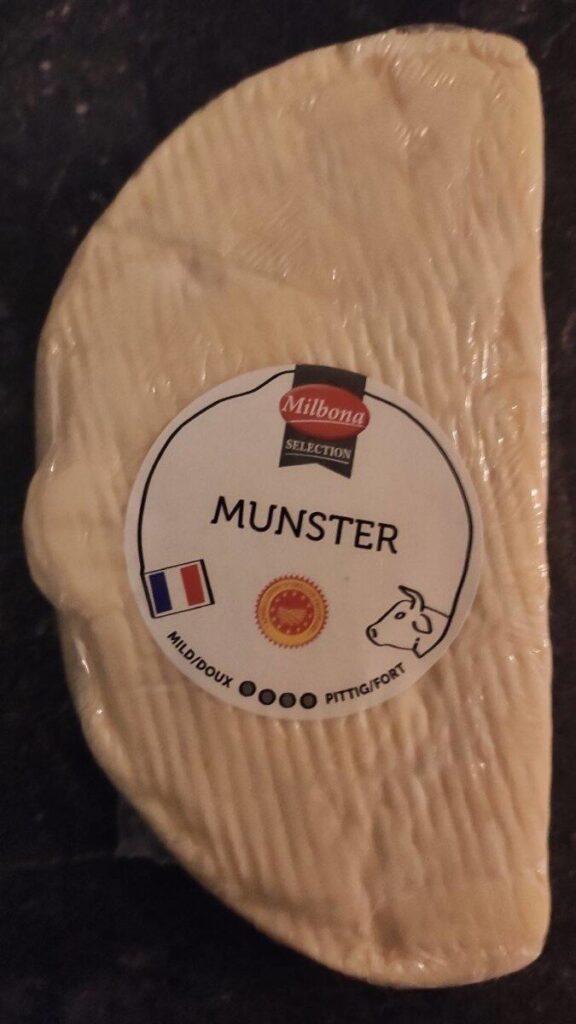
Edam
This will probably come as a surprise to anyone outside France but the French do make Edam Cheese and love it. The first French Edam was made in 1660 in the Medoc region. The rind red colour initially came from the Bordeaux barrels in which the cheese was stored and shipped. Yes, it does taste like the Edams you have tried from elsewhere.
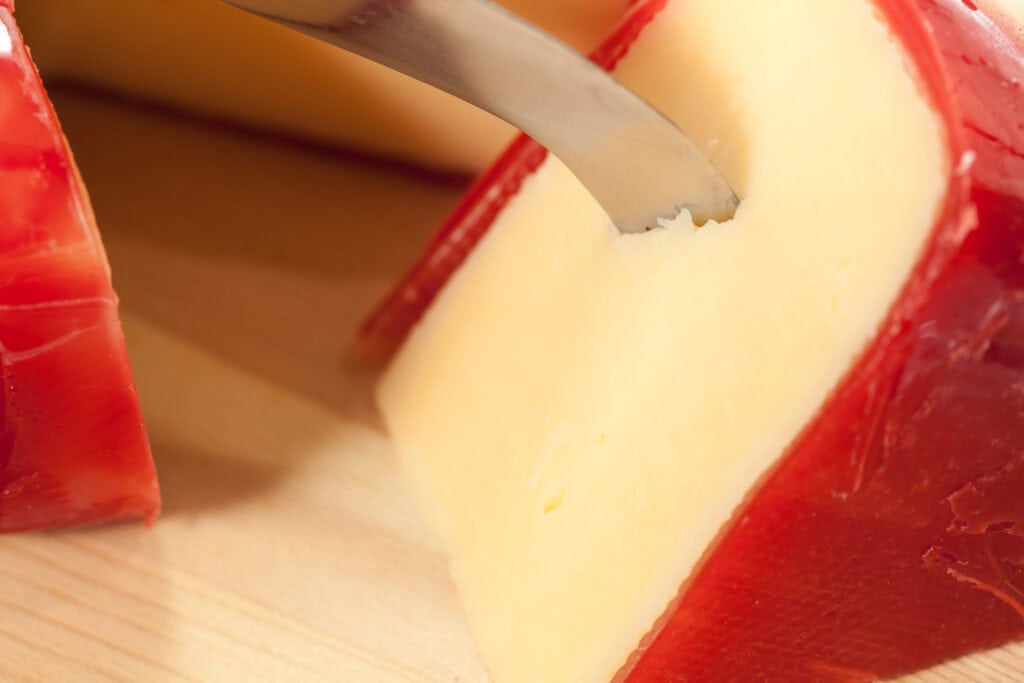
Tomme de Savoie
Tomme simply means a wheel of cheese and it is usually followed by the name of the village that makes the cheese. Tomme de Savoie is made with skim milk, from cows grazing on mountain grasses. With a grey-brown rind, this cheese is quite firm, with a nutty, sometimes grassy flavour.
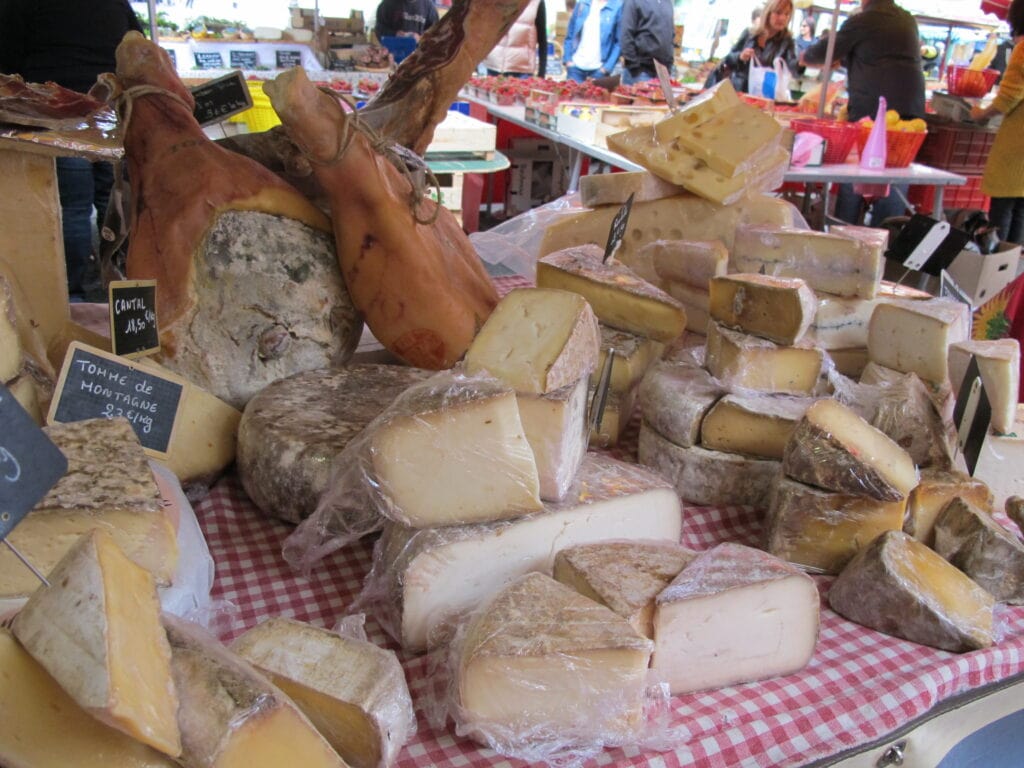
3 French Blue Cheeses to try
Bleu d’Auvergne
Bleu d’Auvergne is made from pasteurized cow’s milk with the Penicillium mould added to give that traditional veined blue-grey mould. This cheese is aged in a cave to control the temperature and has a very distinct smell.
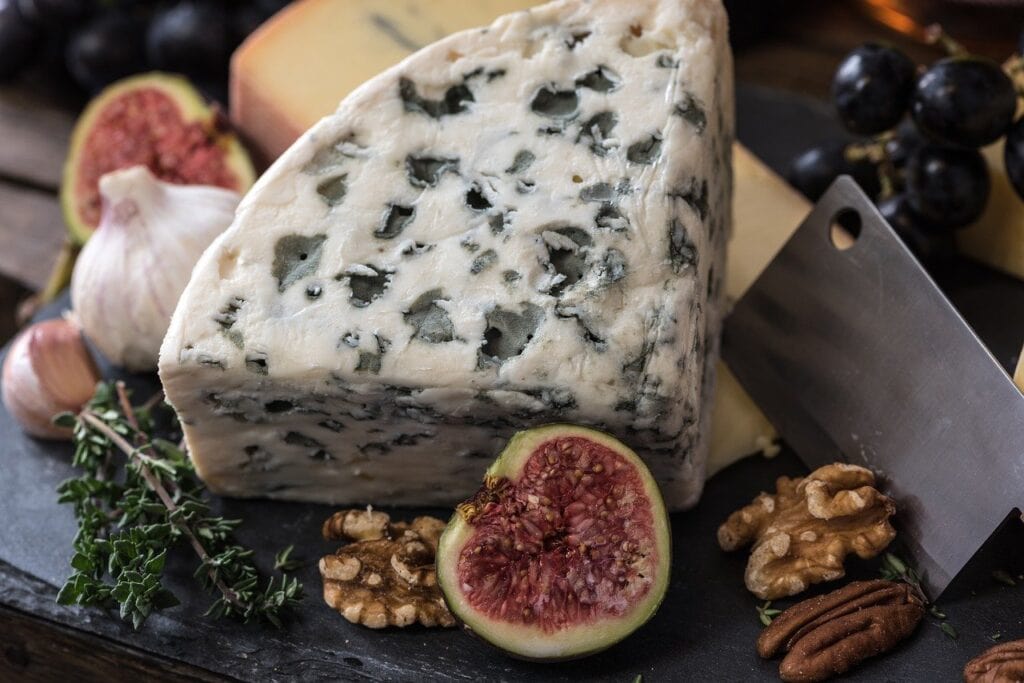
Roquefort
Roquefort on the other hand is made with sheep’s milk. A classic blue cheese is sharp and delightfully pungent with a slightly crumbly texture. According to the cheese legend, a shepherd who was in love left his sandwich in a cave went he went off to make love to his lady and when he returned his cheese had mould on it and from this Roquefort was born.
Diderot was the French philosopher, art critic, and writer who declared the Roquefort “king of cheese”. The Roquefort caves are located in the heart of the Combalou plateau, the “fleurines” bring the airflow needed to the cheese’s development.
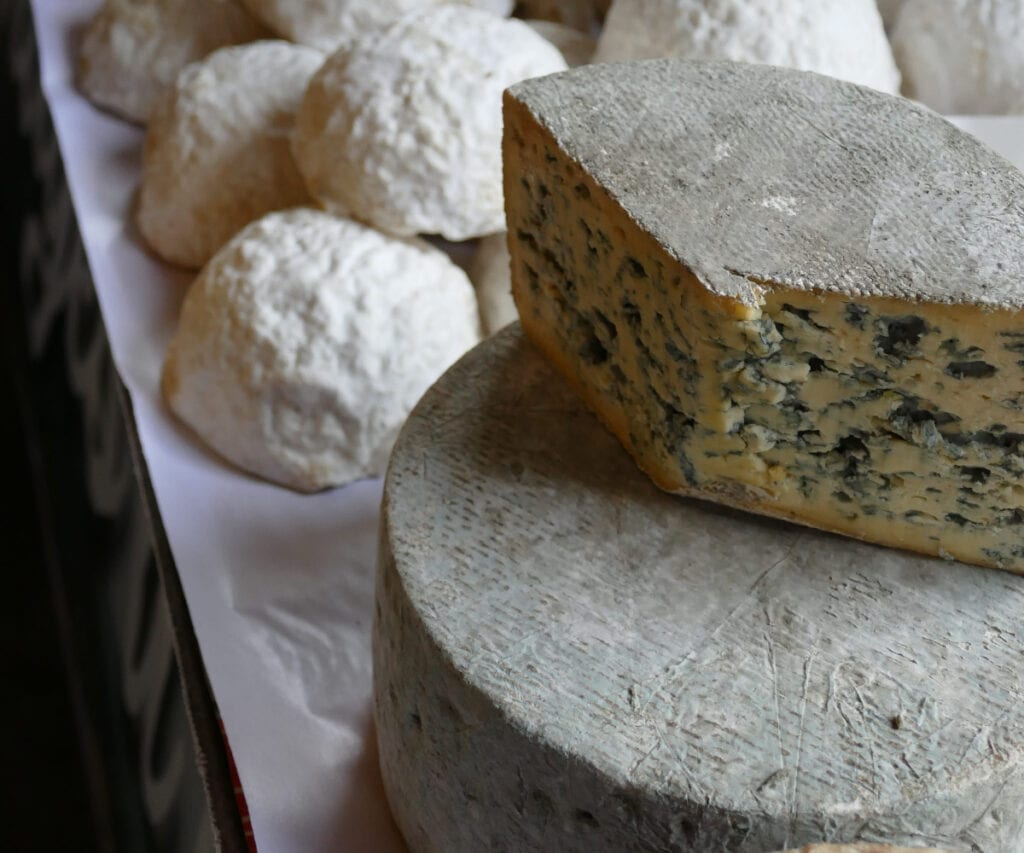
Fourme D’ambert
One of the mildest of blue cheeses, Fourme d’Ambert is creamy with a delicate, fruity flavour, making it an ideal addition to salads or on a cheese board with apple and pear slices.
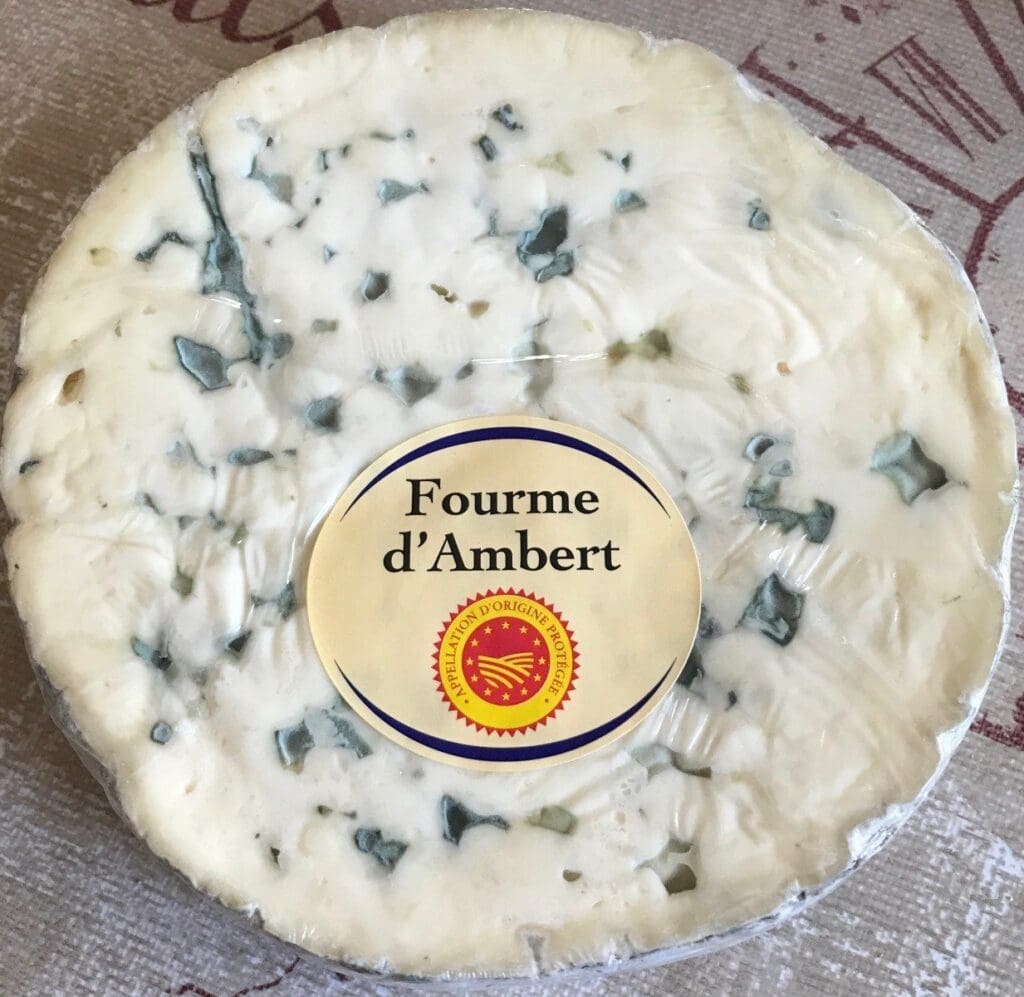
And there you have it 23 French cheeses you have to try. Which ones have you tasted and what was your favourite?
Want to read some more about France?
French Food Culture: The Ultimate Guide
Food in Brittany: Fall in love with the food of Bretagne
The Ultimate guide to visiting Rennes France
Dinan France – medieval France at its finest
Beautiful villages in Normandy
Castles of the Loire Valley France
Chateau de Chenonceau the ultimate guide

